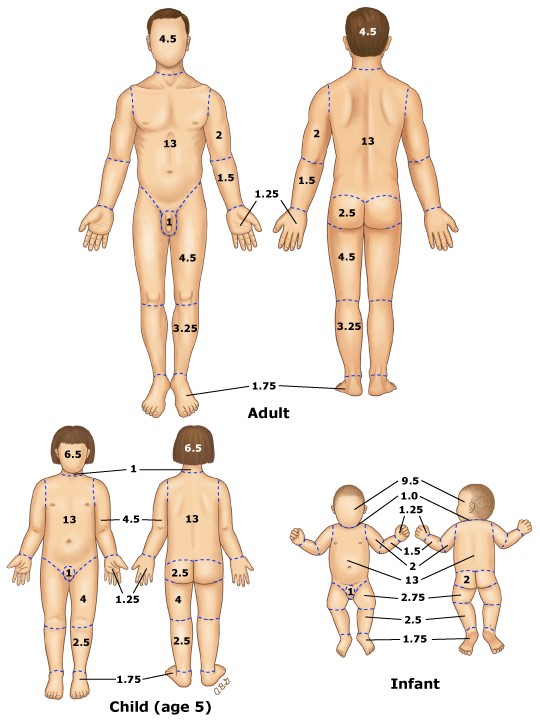A patient experiences a gasoline tank fire when riding a motorcycle and is admitted to the emergency department (ED. with partial-thickness burns on the anterior surfaces of both lower extremities. Which percentage of body surface area should the nurse document in the electronic medical record (EMR)?
18%.
45%.
9%.
36%.
The Correct Answer is A
Choice A reason: This is the correct answer. According to the rule of nines, each leg accounts for 18% of the total body surface area, and the anterior surface of each leg accounts for half of that, or 9%. Therefore, the patient has partial-thickness burns on 9% + 9% = 18% of the body surface area.
Choice B reason: This is incorrect. This would be the case if the patient had partial-thickness burns on the anterior and posterior surfaces of both legs, as well as the head and neck, which is not given in the question.
Choice C reason: This is incorrect. This would be the case if the patient had partial-thickness burns on the anterior surface of only one leg, which is not given in the question.
Choice D reason: This is incorrect. This would be the case if the patient had partial-thickness burns on the anterior and posterior surfaces of both legs, which is not given in the question.

Nursing Test Bank
Naxlex Comprehensive Predictor Exams
Related Questions
Correct Answer is ["B","C","E","F"]
Explanation
Choice A reason: Alcohol consumption will not produce vascular changes is incorrect information. Alcohol consumption can increase blood pressure by causing vasoconstriction, fluid retention, and interference with antihypertensive medications. The nurse should advise the client to limit alcohol intake to no more than one drink per day for women and two drinks per day for men.
Choice B reason: Weight management is promoted by taking daily walks for thirty minutes is correct information. Weight management can lower blood pressure by reducing body fat, improving blood circulation, and enhancing insulin sensitivity. The nurse should advise the client to maintain a healthy weight and engage in moderate physical activity for at least 150 minutes per week.
Choice C reason: Salt substitutes can help with maintaining a healthy diet is correct information. Salt substitutes can reduce sodium intake by replacing sodium chloride with potassium chloride or other minerals. The nurse should advise the client to use salt substitutes sparingly and consult with their healthcare provider before using them if they have kidney disease or take certain medications that affect potassium levels.
Choice D reason: Blood pressure readings should be taken at noontime is incorrect information. Blood pressure readings should be taken at different times of the day, preferably in the morning and evening, to monitor fluctuations and trends. The nurse should advise the client to use a home blood pressure monitor that is accurate and calibrated and follow proper techniques for measuring blood pressure.
Choice E reason: Sodium intake can be regulated by limiting canned foods in the diet is correct information. Sodium intake can increase blood pressure by causing fluid retention and increasing vascular resistance. The nurse should advise the client to limit sodium intake to no more than 2300 mg per day and avoid processed foods that are high in sodium, such as canned foods, soups, sauces, and snacks.
Choice F reason: Uncontrolled hypertension can lead to renal damage is correct information. Uncontrolled hypertension can damage the blood vessels in the kidneys, leading to reduced kidney function and chronic kidney disease. The nurse should advise the client to follow their prescribed treatment plan and monitor their blood pressure regularly.
Correct Answer is C
Explanation
Choice A: Blood alcohol level of 0.09% (90 mmol/L) is not the most important finding for the nurse to report, as this is within the reference range and does not indicate alcohol intoxication or withdrawal, which can affect the client's mental status and mood stability. This is a distractor choice.
Choice B: Six hours of sleep in the past three days is not the most important finding for the nurse to report, as this is a common symptom of bipolar disorder during manic episodes and does not require immediate intervention by the health care provider. This is another distractor choice.
Choice C: Serum lithium level of 1.6 mEq/L (1.6 mmol/L) is the most important finding for the nurse to report, as this indicates lithium toxicity, which can cause neurological and renal impairment and potentially fatal complications such as seizures, coma, and cardiac dysrhythmias. Therefore, this is the correct choice.
Choice D: Weight loss of 10 pounds (4.5 kg) in past month is not the most important finding for the nurse to report, as this may be related to decreased appetite or increased activity during manic episodes and does not pose an immediate threat to the client's health or safety. This is another distractor choice.
Whether you are a student looking to ace your exams or a practicing nurse seeking to enhance your expertise , our nursing education contents will empower you with the confidence and competence to make a difference in the lives of patients and become a respected leader in the healthcare field.
Visit Naxlex, invest in your future and unlock endless possibilities with our unparalleled nursing education contents today
Report Wrong Answer on the Current Question
Do you disagree with the answer? If yes, what is your expected answer? Explain.
Kindly be descriptive with the issue you are facing.
